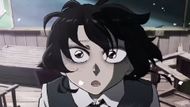Episode 4 of Sanda is an extension of the gloomy, unsettling story that characterizes the recent anime version created by Paru Itagaki. The show has garnered publicity due to its unconventional approach and crass political commentary, set in a dystopian future Japan where Christmas and its culture have been outlawed. At that, Sanda traces a young boy, Sanda, who learns that he possesses the legacy of the legendary Santa Claus. What started as a peculiar fantasy setup has evolved into an allegorical battle between humanity and totalitarian conformity.
This conflict is expressed through a bloody and visceral encounter in Sanda Episode 4, which is the main focus of the episode. This chapter does break the silence of world-building and instead jumps right into action, through the conflict between Sanda and Yagiuda, who was a high-ranking agent of the Red Force, which is run by the government.
This episode marks a decisive tonal shift in the anime; one that reveals the brutality of the system hunting Sanda while exposing his growing understanding of his own power and purpose.

The episode opens with Sanda’s capture attempt, as Yagiuda is dispatched to bring him in alive. Unlike earlier episodes that emphasized mystery and tension, this one chooses unfiltered violence and raw emotion.
Yagiuda’s obsession with his mission quickly becomes apparent; his fight with Sanda is not only physical but ideological. He represents blind devotion to authority, while Sanda embodies defiance through empathy and restraint. The intensity of their clash, set in an isolated and sterile location, mirrors the moral isolation that both characters face in a society where individuality is punished.
As the battle progresses, Sanda Episode 4 turns into one of the most shocking sequences of the series so far. The fight becomes increasingly primal, culminating in the now-discussed “naked battle” scene that has drawn both controversy and critical analysis. The act of removing the clothes of both characters was far not understated as the overall metaphor of vulnerability and loss of artificial identity.
Physical exposure is a storytelling device used by Paru Itagaki to describe the process of unveiling the masks that have been imposed by the state to show the true natures of the characters. The opposition of compassion and control is in sharp contrast, as Sanda fights unwillingly yet brutally, whereas Yagiuda does it with a lot of bloodshed.
The Raw Symbolism and Technical Precision in Sanda Episode 4
Thematically, the physicality of violence in Sanda Episode 4 supports the anti-authoritarian theme of the series. The persona of Yagiuda is the personification of indoctrination; his line during a fight resembles the propaganda that is the core of the Red Force ideology. He discusses innocence, discipline, and submission-values that have become instruments of oppression. The fact that Sanda resists killing even during a fight itself shows his internal struggle and predetermines his transition into the symbol of hope in the world, which denies emotion and faith.
Fight choreography in episode 4 of the show Sanda is worth singling out because of its intensity and its pacing. Each hit and grapple is burdened with significance, and the animation retains the traditional art style of Itagaki, which he had: Expressive anatomy, aggressive linework, and realism of the soul.
The move to restrict background music in some scenes increases the feeling of awkwardness, compelling the audience to pay attention to the naked sound of battle. The editing and the direction collaborate to ensure that the tension and the theme are not over-romanticized by the violence.

This episode also gives more insight into what Sanda changed into. Flashbacks throughout the fight depict his eventual understanding of what exactly Santa is, kindness and rebellion existing in a world that does not accept either. His rising in the face-off with Yagiuda is both emotional and physical. His fight against fear and his fight not to seek revenge but to survive is the moral nature of the series. Defiance by Sanda is the first open rejection of the absolute control of the system by the end of the episode.
Episode 4 of Sanda is visually impressive. The dark color cast, where grays and chilly blues prevail, contributes to the feeling of oppression. On the contrary, the short red and white images may be understood as a reference to Christmas since they provide visual hints to what the world had lost. The cinematography and the lighting of the episode focus on physical movement and emotional tension to make the scene look more like a psychological duel than a typical anime fight.
This episode acts as a transition and a climax narratively. It is the first real win of Sanda, yet the loss of Yagiuda means the rise of the Red Force. It lacks any moment of triumph, just weariness and seeing through. The episode is left on a silent yet tense note, suggesting that the fight has only widened the gap between the humanness of Sanda and the dehumanized world he lives in.
To sum up, episode 4 of Sanda is one of those moments that defined the first arc of the anime: A brutal show of fight, identity, and resistance. It combines crude physical violence with a complex symbolism, extending animation and narration to extremes.
The episode parades the weakness of its characters as a reminder to the viewers of the price of empathy in a control-dominated society. Driven by incredible direction, animation, and script, Sanda still demonstrates that it is not just a dystopian fantasy but a chilling reminder of the moral decadence of the world.
